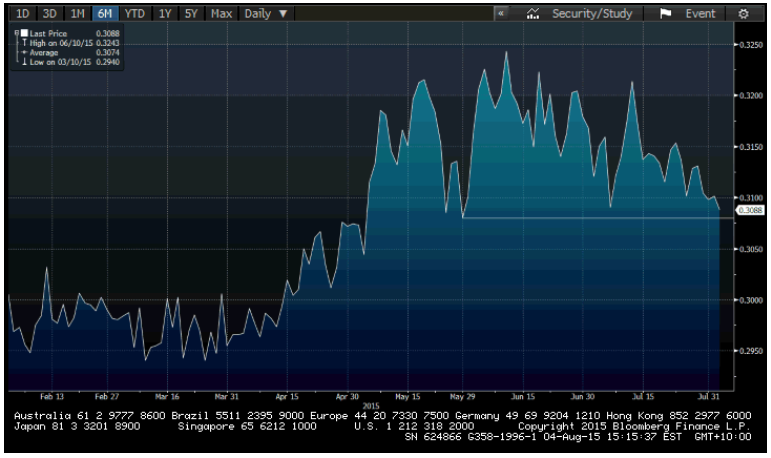It’s generally been an upbeat session here in Asia despite continuation deterioration in oil and inflation expectations.
It seems the bulls have had a better say in Australia and China and certainly I think price action in Australia looks quite interesting. I would say even the bulls would have put a low probability of a clean break through the key 5,700 area for the ASX 200 pre-market, but not only did we see a break through the June/July double-top but we have seen good volume on the break as well. The RBA to blame for the loss of momentum, although the index is still modestly above 5,700.
The S&P/ASX 200 is clearly having a strong outperformance of late with the MSCI World/ASX 200 ratio falling quite aggressively of late. The 5% fall in the AUD during July has clearly assisted that trade and is certainly a reason why CSL (ASX:CSL) has broken the A$100 barrier today. As far as momentum plays go in the Aussie stock market, this is about as bullish as it gets; pullbacks will remain supported. The question remains how much further CSL can go and with price now at A$101, it is trading at premium to the consensus analyst’s price target of $100.72 – the first time since April. The last time price crossed the brokers target, we subsequently saw a 6% increase in analysts’ price targets. However, I am skeptical we will see the same this time around. This is a name to stay in or buy on pullbacks in my opinion, but it is clear that the market is telling you this is a quality business and investors seem happy to pay up for the cash flows and earning streams.
Staying equities specific, Suncorp (ASX:SUN) have really lifted expectations for Aussie reporting season, although the market seemingly misinterpreted the financials on first blush. The diversified financial has had a good run since early May and the market clearly wanted to see pleasing numbers. After seemingly disappointing at first, we saw a strong reversal, with traders compelled by the performance of its general insurance business and the lower and doubtful debts. Personally, I was keen to watch out for the dividend payout ratio, given increasing payout ratios will be a key reason for the ASX 200 to attract offshore capital and at 81%, it seems this resonated through the market and reinforced the idea that other firms will follow suit with returning capital to shareholders.
Two sectors that should be avoided by investors are the material and energy space. Both are sectors that are great for traders but make terrible investments. Companies such as Rio Tinto (LONDON:RIO) or BHP (NYSE:BBL) are producing at low levels, but in the end commodities have such limited visibility right now and provide such little confidence to shareholders. We have seen the Impact first hand of late with massive job cuts in Chevron (NYSE:CVX), Shell (LONDON:RDSa) and Anglo American (LONDON:AAL) of late. Still, we should see dividend increases for Rio (A$1.07 VS A$0.96 in 2014), although analysts do expect BHP to keep theirs steady, while FMG (ASX:FMG) should drop their dividend to 6¢.
Of course the big talking point today has been the huge data drop in Australia, and if the UK will be celebrating ‘super Thursday’, today is Australia’s ‘super Tuesday’! We saw a modest 20-30 pip move in AUD/USD after the 0.7% rise in nominal retail sales, but this did little to alter the future perception on rates and it will take something more than stronger retail turnover to change Glenn Stevens view.
This came across firmly in today’s Reserve Bank statement, although the fact that the central bank have altered its view that on the currency from further falls a ‘likely and necessary’ and now simply suggesting the AUD is ‘adjusting to significant declines in commodity prices’ is actually quite bizarre. The strategy was working well! There was a slow gradual decline in the AUD, despite stabilisation in its key export commodity, which is what all central banks desire. This could and should alter somewhat now, although the market is still pricing a 68% chance of a rate cut by December (from 73% pre-RBA statement). However, for currency traders the RBA has just given us a reason to leave the AUD out of the central bank divergence trade, as the RBA are on hold for a long time. Trader’s preference has firmly shifted to selling NZD, CAD, NOK and SEK, but AUD is firmly in the neutral camp for now.
Japan is once again sidelined, although traders have been keen to focus on a slight drop (to 32.8% from 34.2%) in the pace of expansion in the monetary base. We have also seen an unexpected 2.9% drop in real cash earnings. This won’t please the Bank of Japan at all, but it won’t push them into increasing the current QE program from a monthly run rate of ¥80 trillion. The barrier to that feat is way too high right now.
USD/JPY seems to be missing a catalyst and while it’s hard to find a strategist who doesn’t feel the pair is going higher over a medium or long-term time frame, everyone seems to want to buy on a break of the ¥124.50 triple top. Letting the market dictate can often be a great strategy and while the US yield curve is flattening as a result of better buying in the 10 and 30 year maturities, the USD seems to be missing a catalyst.
Yesterday’s US ISM manufacturing had its positives and negatives, but the fact new export orders showed good contraction won’t bode well for future GDP reads. USD bulls will point to the fairly low contribution from exports as a percentage of GDP (currently around 12%), but it’s worth keeping in mind that the consensus estimate for Q3 GDP is currently 3%, although there would be downside risks to that call.

